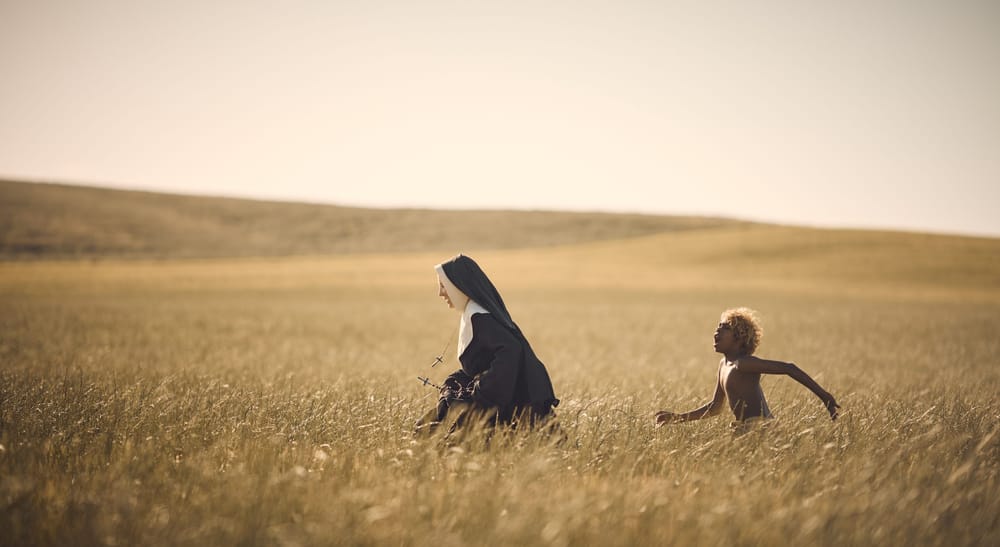Some films don’t just unfold—they breathe. The New Boy, Warwick Thornton’s latest offering, is one of those rare works that moves with the quiet rhythm of something deeply sacred. Set against the sun-scorched landscape of 1940s Australia, it hums with the breath of ancient spirits, colonial ghosts, and the longing silence between them. It is at once myth and memory, parable and poem.
We begin with a boy—barefoot, wild-eyed, unnamed. Caught by police in the outback, he’s thrown into a sack, subdued with a boomerang, and sent by train to a Catholic orphanage nestled in the hills. He arrives like a whisper in the dark, his hair untamed, his language unspeakable to those around him. He is called only “New Boy,” and his silence is not emptiness but a quiet resistance to erasure.
The orphanage is presided over by Sister Eileen, played with raw honesty by Cate Blanchett. Her habit is frayed at the edges, and her faith runs deep—but not unshakeable. She hides secrets, buries the dead, and pretends the priest still lives, sending forged letters to headquarters with firm assurance. Alongside her are Sister Mum (Deborah Mailman), warm and earthy, and George (Wayne Blair), the Indigenous handyman who sees in the boy something powerful, something ancient—something neither the Church nor its rituals can contain.
There’s a tenderness in the way this story is told. Thornton, as always, directs with his eye on the land first. The baked red soil, the shimmer of heat rising off dry leaves, the endless stretch of golden light—every frame is painted with reverence. He captures the landscape not just as setting, but as presence. It speaks. It listens. It waits.
The New Boy is not here to be tamed, and the film never asks him to be. He walks barefoot across the chapel floor, avoids cutlery like a defiant ritual, and prefers to sleep beneath his bed. He carries with him an old kind of knowledge, one that pulses beneath his skin in quiet flashes of glowing light. There are moments where the spiritual and physical worlds seem to blur around him—a shimmer in the air, a halo in the palm of his hand—and though we may never fully understand what he is, the film gently suggests that this mystery is exactly the point.
Nick Cave and Warren Ellis’ haunting score folds itself around the film like incense smoke, thick and meditative. The music doesn't lead so much as linger, hovering in the quietest spaces: beneath the creak of wooden floors, between the lines of scripture, within the boy’s stillness. It elevates the film’s ethereal tone, never overwhelming, always just enough.
Aswan Reid, in his debut role, is utterly magnetic. He says almost nothing, yet says everything with a glance, a gesture, the tilt of his head toward the sky. His performance is one of quiet gravity—he draws us in without ever reaching, and we follow him willingly. Cate Blanchett, always extraordinary, disappears into Sister Eileen with a kind of weary grace. Her faith is her armor, her guilt the chisel that cracks it. She doesn’t so much lose her footing as come to realize it was never solid to begin with.
There’s a scene late in the film—simple but staggering—where the New Boy stands before a life-sized crucifix newly delivered to the orphanage. His face is unreadable, but his eyes are fixed, wide. There’s no fear, no reverence—only an aching curiosity. What is this man on the cross to him? What does salvation mean when it’s offered through foreign symbols, in a language not your own?
And that’s where The New Boy does something quietly radical. It doesn’t shout. It doesn’t rage. Instead, it watches, listens, and questions. It asks what happens when two belief systems meet and neither fully understands the other. It asks what is lost in translation—and what might be found in the space between. It doesn’t condemn; it contemplates.
The film could have taken the easy path of indictment, of heavy-handed messaging or didactic blame. But Thornton resists. Instead, he offers something softer, sadder, and far more powerful: a boy who glows, a nun who doubts, and a world that keeps spinning with or without our understanding.
The ending arrives not as a conclusion but a quiet release—like the final breath of a prayer whispered into the wind. We are not given answers, only echoes. The boy walks into the bush, barefoot and unbound, the dawn behind him. And we are left, heart open, spirit stilled, wondering not what he is, but who we are in his presence.
In The New Boy, Thornton has crafted more than a story—he’s offered a gesture of grace. It’s a film that lingers like the scent of eucalyptus after rain, like the echo of a hymn long after the final note fades. In its silence, it speaks volumes.
And when the last image dissolves into the golden dust of morning, you’ll feel it not just in your mind, but in your bones—that old magic still walks among us. And sometimes, it looks like a barefoot boy with light in his hands.
Director: Warwick Thornton
Cast: Aswan Reid, Cate Blanchett, Deborah Mailman
Writer: Warwick Thornton
Producers: Cate Blanchett, Lorenzo De Maio, Georgie Pym, Kath Shelper, Andrew Upton
Composers: Nick Cave, Warren Ellis
Cinematographer: Warwick Thornton
Editor: Nick Meyers
Screening or Streaming Availability:

